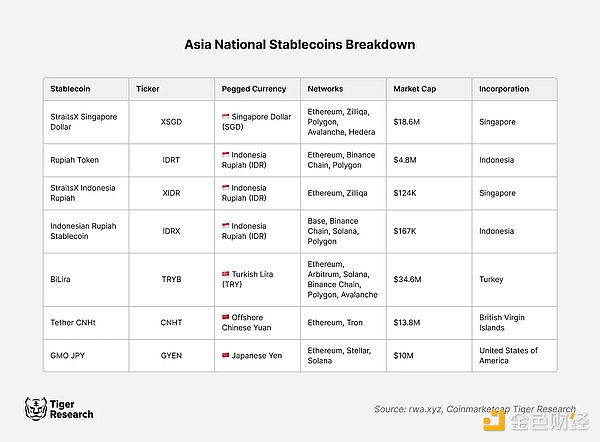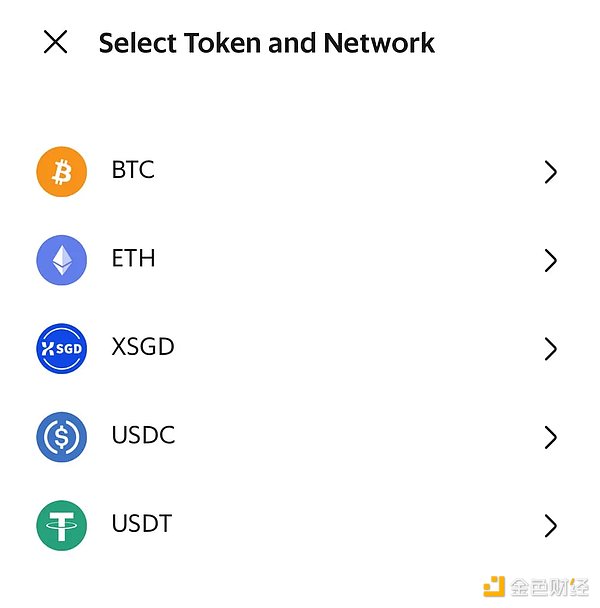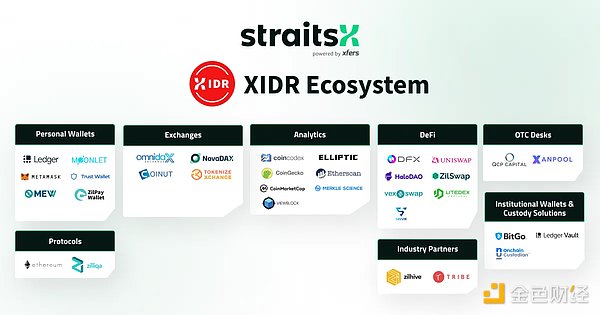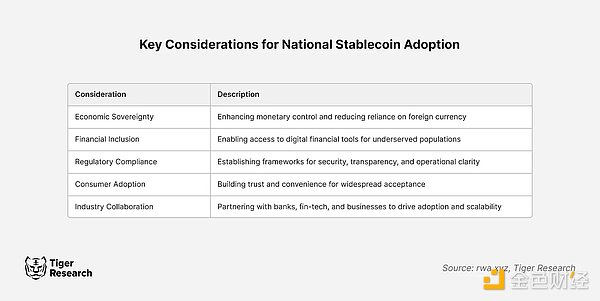Author: Tiger Research
Key Points
National Stablecoins Grow in Asia: Several Asian countries are developing stablecoins pegged to local currencies to maintain monetary sovereignty and reduce reliance on the U.S. dollar for global trade. These stablecoins improve the efficiency of cross-border payments and align with national financial strategies in countries such as Singapore and Indonesia.
Case Studies Show: Projects such as XSGD have paved the way for stablecoin adoption, making transactions faster and cheaper while reducing currency exchange costs. However, challenges remain, such as limited usage and market adoption of small stablecoins such as XIDR.
Key Steps for Wider Adoption: For national stablecoins to realize their full potential, governments should focus on conducting feasibility studies, running pilot projects, and establishing clear regulatory frameworks. Collaboration between the public and private sectors is essential to overcome technical, regulatory, and operational barriers.
1. Dynamic shift in stablecoin adoption
Currently, most stablecoins are pegged to the U.S. dollar (USD), which reinforces the dollar’s dominance in global finance. However, Asia has begun to shift toward issuing stablecoins pegged to local currencies. This change is consistent with broader global economic trends, as many countries look to reduce their reliance on the dollar in trade, investment, and financial transactions.
The core question this report seeks to explore is: Why do some Asian countries issue non-USD stablecoins despite the dominance of the USD? To answer this question, we will examine the benefits of national stablecoins, highlight key case studies, and explore how non-USD stablecoins are playing an increasingly important role in the Asian financial landscape.
2. Benefits of national stablecoins
The main motivation for issuing national stablecoins is to maintain monetary sovereignty. By pegging stablecoins to their national currencies, countries can ensure that their monetary policies are aligned with national economic goals. This allows for greater control over economic and political outcomes. Countries can better manage external economic pressures, which is particularly important during periods of volatility in foreign exchange markets.
Many countries in Asia, especially those that have experienced currency crises, are particularly sensitive to these issues. This makes stablecoins an attractive tool for enhancing economic stability and resilience. However, most countries have prioritized the development of central bank digital currencies (CBDCs) over stablecoins issued by private companies.
CBDCs provide governments with more direct control over monetary policy and the financial system, making them easier to regulate than private stablecoin alternatives. Currently, only a few countries allow the issuance of stablecoins. Most are still developing regulatory frameworks and considering implementation.
However, limiting the popularity of dollar stablecoins such as USDT and USDC is a challenge. In South Korea, it is estimated that about 10% of trade is conducted through dollar stablecoins, and these transactions are generally not recorded in official statistics. Recognizing these practical limitations, governments are accelerating their efforts to develop policies to help them compete effectively in the global stablecoin market.
3. Case Study: Asian Non-USD Stablecoin Projects

3.1. StraitsX Singapore Dollar (XSGD)
Issued by StraitsX, XSGD is a Singapore dollar-backed stablecoin that runs on Ethereum and has expanded to 4 other networks. With a market cap of over $18 million, XSGD has quickly become one of the most trusted stablecoins in Asia due to its incorporation under the Payment Services Act of the Monetary Authority of Singapore (MAS).

Users can top up in Grab App using XSGD. Source: blockhead.co
XSGD enables seamless cross-border transactions in Singapore dollars, benefiting businesses and traders operating in Southeast Asia. In 2024, Singaporean super app Grab will allow users to top up their digital wallets with cryptocurrencies including XSGD, expanding its usefulness in everyday transactions. By using a stablecoin pegged to the Singapore dollar, companies can avoid exchanging dollars, save on conversion fees, and increase transaction speeds.
3.2. Indonesian Rupiah Token (IDRT)
Issued by PT Rupiah Token Indonesia, IDRT is a stablecoin pegged to the Indonesian Rupiah (IDR). It has a market cap of over $4.8 million and runs on networks such as Ethereum and Binance Chain. While the Indonesian government does not promote a specific stablecoin, it has expressed support for blockchain technology as part of its broader goal of increasing financial inclusion and supporting the digital economy.

Source: rupiahtoken.com
IDRT is widely used on various CEXs and DEXs, such as Binance, Uniswap, and PancakeSwap, allowing users to trade and invest in currencies pegged to the Indonesian rupiah. This accessibility on popular exchanges expands IDRT's role in the decentralized finance (DeFi) ecosystem, making it a practical tool for users seeking exposure to the Indonesian currency in the cryptocurrency space.
3.3. Straits Times Indonesian Rupiah (XIDR)

XIDR Ecosystem. Source: StraitsX
XIDR is also issued by Xfers, pegged to the Indonesian Rupiah, and is part of the wider StraitsX ecosystem, which includes XSGD. Although XIDR has a relatively small market cap of $124,960, it shows potential for growth, especially as Indonesia integrates blockchain solutions into its financial infrastructure.
Compared to IDRT, XIDR has a wider ecosystem, supporting multiple DeFi platforms, institutional custody solutions, and a wider range of personal wallet options, which may give it wider utility in various fields such as decentralized finance and institutional trading. Although XIDR is involved in multiple fields, its market capitalization is lower than IDRT. This may be because IDRT has established a foothold in this field earlier. In the future, XIDR may play a key role in the Southeast Asian financial sector, providing fast and efficient payment services to online retailers throughout the region.
3.4. Indonesian Rupiah Stablecoin (IDRX)
Developed by PT IDRX Indo Inovasi, IDRX is a stablecoin pegged to the Indonesian rupiah that runs on multiple blockchain networks including Base. Its main goal is to connect traditional finance and Web3 by providing a stable digital representation of the Indonesian national currency.

Source: IDRX
Similar to other stablecoins, IDRX is committed to enabling decentralized financial applications, facilitating cross-border payments and remittances, and providing stability to hedge against cryptocurrency market volatility. Although still in its early stages, IDRX has already partnered with Indodax, the largest cryptocurrency exchange in Indonesia by market share. Although it is not yet equipped with advanced features such as a fair trading mechanism, the project shows great potential for widespread adoption and functional expansion, strengthening its role in Indonesia's growing digital economy.
3.5. BiLira Turkish Lira (TRYB)
BiLira (TRYB) is a Turkey-based stablecoin pegged to the Turkish Lira and is an Ethereum-based stablecoin that provides relevant insights into the Asian market. With a market capitalization of approximately $34.6 million, BiLira operates without direct regulation and is riskier, but fills a gap in cross-border payments involving the Turkish Lira. In addition, BiLira, the developer of TRYB, launched its innovative cryptocurrency exchange BiLira Kripto. The platform provides users with more channels to trade and transact with stablecoins backed by the Turkish Lira.
However, given the continued instability of the Turkish Lira against the US dollar, 4% of Turkey's GDP is currently spent on purchasing stablecoins. This poses a significant challenge for local stablecoins such as BiLira to compete with dominant currencies such as the US dollar.
3.6. Tether CNHt (RMB)
Tether CNHt is pegged to the offshore Chinese yuan (CNY) and serves as a stablecoin for international trade by Chinese businesses. Despite China’s strict regulation of cryptocurrency activities, CNHt allows businesses to settle transactions in RMB without the volatility of the exchange rate, providing a solution for traders who wish to trade in RMB.
However, it is worth noting that Tether CNHt competes with the official Chinese digital yuan (also known as e-CNY), which has seen wider adoption in China. The digital yuan has been heavily promoted by the Chinese government, has been integrated into the domestic financial system, and has gained favor among retail and institutional traders due to its legal status and the support of the People’s Bank of China. In addition, its recent integration with Huawei’s HarmonyOS NEXT operating system has greatly improved its accessibility, further consolidating its position in China’s digital financial ecosystem.
In contrast, Tether CNHt is positioned in the offshore market and international transactions, providing an alternative to dollar-pegged stablecoins. In terms of domestic use, the digital RMB is increasingly used in daily transactions, such as retail payments in Beijing and Shanghai. This widespread promotion makes it more popular in mainland China compared to private stablecoin alternatives such as CNHt.
3.7. GMO Japanese Yen (GYEN)
GMO JPY (GYEN) is a stablecoin issued by GMO Trust, a regulated entity based in the United States. GYEN is pegged to the Japanese Yen (JPY), runs on Ethereum, and has a market capitalization of $10 million. Unlike other stablecoins that are mainly aimed at retail or emerging markets, GYEN aims to serve institutional clients, providing a safer and more regulated alternative for businesses that use Japanese yen for transactions. Bitstamp is one of the first CEXs to accept GYEN, marking its move in the crypto industry.
On the legal side, the stablecoin complies with New York State’s strict financial regulations, ensuring high transparency and consumer protection. Although GYEN is not regulated by Japanese law and is not currently permitted for use in Japan, Japan’s positive attitude toward blockchain and fintech developments suggests the potential for future regulatory adjustments that could integrate assets such as GYEN into the country’s digital financial ecosystem.
4. Key Considerations and Conclusions
4.1. Key Considerations
With growing interest in national stablecoins across Asia, governments and businesses are exploring tangible steps to integrate these digital currencies into their economies. The table below outlines the main use cases, associated benefits, and challenges for the adoption of national stablecoins.

The table below highlights the essential elements needed for the successful adoption of national stablecoins. Economic sovereignty is the core driver, as stablecoins offer countries a way to reduce their reliance on foreign currencies and strengthen control over their domestic monetary systems. This is particularly important for countries with volatile currencies or facing external economic pressures.
Regulatory compliance and consumer trust are equally important. Governments must establish clear frameworks to ensure transparency and prevent abuse, while companies need to provide secure, user-friendly systems to earn public trust. Stablecoins also offer a way to improve financial inclusion by extending digital financial tools to underserved populations, especially in areas with limited banking services.
Finally, cross-sector collaboration is critical. Strategic partnerships between governments, fintech companies, and traditional financial institutions will determine how well stablecoins fit into the existing ecosystem. By addressing these issues holistically, countries can lay a solid foundation for stablecoin adoption that is aligned with their economic and social priorities.
4.2 Conclusion
National stablecoins offer Asian countries a unique opportunity to strengthen their financial sovereignty, improve monetary management, and modernize their payment systems. By pegging stablecoins to local currencies, governments can create digital instruments that align with domestic priorities and offer a secure and efficient alternative to traditional systems.
However, stablecoin adoption must follow a structured approach, including rigorous feasibility assessments, pilot programs, and a transparent regulatory framework. Through strategic collaboration between public institutions and private enterprises, national stablecoins can lay the foundation for sustainable economic growth and innovation. This, in turn, could pave the way for future applications such as cross-border trade and regional cooperation.
 Hui Xin
Hui Xin
 Hui Xin
Hui Xin Alex
Alex Jasper
Jasper YouQuan
YouQuan Jixu
Jixu Kikyo
Kikyo Hui Xin
Hui Xin Alex
Alex Catherine
Catherine Clement
Clement